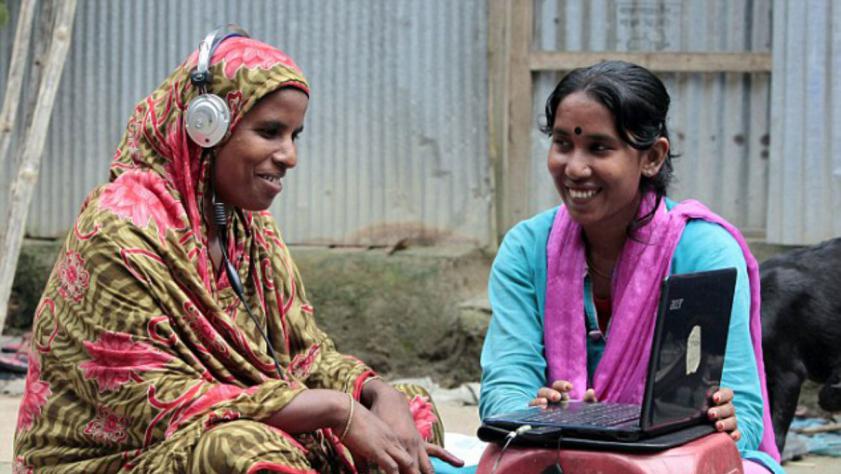Infrastructure and technology have played an important role in bringing about such changes which, in turn, have led to economic and social transformation. For example, road infrastructure in rural areas has created employment and income opportunities for both men and women in many ways. Poor and landless people, including destitute women, can work in construction and maintenance of road. On the other hand, improved roads have reduced travel time and increased accessibility of jobs outside rural areas. Better infrastructure has also enabled us to develop rural markets. Private investments for shops, restaurants, pharmacies, tea stalls, saloon, etc. have created employment opportunities for the rural population. Expanded connectivity between rural and urban areas has also increased the value of land significantly.
Better roads have reduced travel time and increased access to social services including health and education. As a result, mobility of women, both in terms of work and accessing maternal and child healthcare programmes, has increased. A large number of schools in rural areas operated by both the government and non-government organisations have contributed to increased accessibility of rural girls to education.
The other stimulus has come from the use of technology in rural areas. Farmers are now able to receive market information through mobile services. A large number of women enjoy services provided by mobile technology. Mobile-based services such as mobile money, healthcare, education and information and helpline services have flourished in Bangladesh rapidly during the last decade. These have created opportunities for rural livelihoods.
Participation in microcredit by a large number of women has undoubtedly increased their household income and empowered them socially. Additionally, technology and information flow has also contributed towards empowerment of women. Girls’ education has not only created increased employment opportunities for them, but it has also made a positive impact in a number of areas, including increased decision-making power of women and girls, higher marriage age of girls and greater say in choice of spouse. Women’s education and access to information are critical factors for increased use of maternal health services and improved health outcomes, as well as reduced fertility and improved family nutrition.
 Despite such spectacular changes, rural Bangladesh lags far behind urban areas on many counts. With about 70 percent people living in rural areas, economic and social opportunities are far less than that of urban areas. The rural-urban divide is obvious in poverty statistics. The Household Income and Expenditure Survey 2010 shows that the percentage of people living below the poverty line is much higher in rural areas than both the national and urban levels. For example, according to the HIES 2010, the incidence of extreme poverty is 17.6 percent at the national level, 21.1 percent in rural areas and 7.7 percent in urban areas. Similar trends exist in case of access to health, education, technology, water, sanitation, electricity and other services.
Despite such spectacular changes, rural Bangladesh lags far behind urban areas on many counts. With about 70 percent people living in rural areas, economic and social opportunities are far less than that of urban areas. The rural-urban divide is obvious in poverty statistics. The Household Income and Expenditure Survey 2010 shows that the percentage of people living below the poverty line is much higher in rural areas than both the national and urban levels. For example, according to the HIES 2010, the incidence of extreme poverty is 17.6 percent at the national level, 21.1 percent in rural areas and 7.7 percent in urban areas. Similar trends exist in case of access to health, education, technology, water, sanitation, electricity and other services.
Hence with the majority of the poor located in rural areas, the real effort towards poverty alleviation initiative has to be focused more on rural poverty alleviation. Diversified employment opportunities and increased productivity can play a key role here. Though the share of agriculture in the economy has reduced over time, a large number of people still eke out their livelihoods from agricultural activities. With a share of only about 18 percent of the total gross domestic product, the agriculture sector absorbs 42 percent of the total labour force of the country. Understandably, productivity per labour is very low as there is an excess supply of labour. This pushes agricultural wages downward.
Again, the adoption of technology in the agriculture sector is crucial. With limited agricultural land, technological innovation for high-yielding varieties has played a key role in higher production. However, innovation in the agriculture sector has to be an ongoing process as the country is vulnerable to weather variability and climate change. Water-tolerant and drought-resistant crop variety has been introduced in recent times. But there is still scope for further adoption of advanced technologies in the sector for diversification of agricultural commodities and production of high-value crops for the export market. This requires increased resource allocation for research and development for the agriculture sector. Skills development of human resources is equally important.
The recently launched “The Least Developed Country Report 2015” by the United Nations Conference on Trade and Development has highlighted some of these challenges to rural transformation. While the importance of the rural economy for holistic development is undeniable, we tend to overlook this reality, preferring to focus all our attention to the urban economy. However, as we enter into a new global development regime in the post-2015 period, the focus has to shift more towards a balanced growth both in urban and rural areas. Eradication of poverty of all forms and from everywhere, as outlined in Sustainable Development Goal 1 formulated by the UN, is not possible without poverty alleviation in rural areas where a lion’s share of poor people live.
 RURAL Bangladesh is changing its face. Both physically and structurally. With the rise of various new and emerging activities, today’s rural economy is different from that of the eighties or nineties. Not only is there more concrete and electricity, one now finds agents of bKash helping to send and receive money through mobile phones or info-ladies equipped with a laptop, mobile phones and apparatus travelling on bicycles providing advice on health, family planning, education, legal issues and marketing. One also finds beauty parlours and cyber shops.
RURAL Bangladesh is changing its face. Both physically and structurally. With the rise of various new and emerging activities, today’s rural economy is different from that of the eighties or nineties. Not only is there more concrete and electricity, one now finds agents of bKash helping to send and receive money through mobile phones or info-ladies equipped with a laptop, mobile phones and apparatus travelling on bicycles providing advice on health, family planning, education, legal issues and marketing. One also finds beauty parlours and cyber shops.

 Despite such spectacular changes, rural Bangladesh lags far behind urban areas on many counts. With about 70 percent people living in rural areas, economic and social opportunities are far less than that of urban areas. The rural-urban divide is obvious in poverty statistics. The Household Income and Expenditure Survey 2010 shows that the percentage of people living below the poverty line is much higher in rural areas than both the national and urban levels. For example, according to the HIES 2010, the incidence of extreme poverty is 17.6 percent at the national level, 21.1 percent in rural areas and 7.7 percent in urban areas. Similar trends exist in case of access to health, education, technology, water, sanitation, electricity and other services.
Despite such spectacular changes, rural Bangladesh lags far behind urban areas on many counts. With about 70 percent people living in rural areas, economic and social opportunities are far less than that of urban areas. The rural-urban divide is obvious in poverty statistics. The Household Income and Expenditure Survey 2010 shows that the percentage of people living below the poverty line is much higher in rural areas than both the national and urban levels. For example, according to the HIES 2010, the incidence of extreme poverty is 17.6 percent at the national level, 21.1 percent in rural areas and 7.7 percent in urban areas. Similar trends exist in case of access to health, education, technology, water, sanitation, electricity and other services.